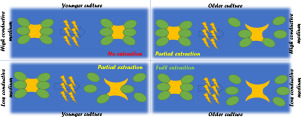Bioelectrochemistry ( IF 4.8 ) Pub Date : 2018-04-25 , DOI: 10.1016/j.bioelechem.2018.04.016 Alexis Guionet , Bahareh Hosseini , Hidenori Akiyama , Hamid Hosano

|
The green algae Botryococcus braunii produces a high amount of extracellular hydrocarbon, making it a promising algae in the field of bio-fuels production. As it mainly produces squalene like hydrocarbons, cosmetic industries are also interested in its milking. Pulsed electric fields (PEF) are an innovative method allowing oil extraction from micro-algae.
In common algae accumulating hydrocarbon inside cytoplasm (Chlorella vulgaris, Nannochloropsis sp., etc), electric fields can destroy cell membranes, allowing the release of hydrocarbon. However, for B.braunii, hydrocarbons adhere to the cell wall outside of cells as a matrix. In a previous article we reported that electric fields can unstick cells from a matrix, allowing hydrocarbon harvesting.
In this work, we deeper investigated this phenomenon of cell hatching by following 2 parameters: the conductivity of the medium and the cultivation duration of the culture. Cell hatching is accurately evaluated by both microscopic and macroscopic observations.
For high conductivity and a short time of cultivation, almost no effect is observed even after up to 1000 PEF pulses are submitted to the cells. While lower conductivity and a longer cultivation period allow strong cell hatching after 200 PEF pulses are applied to the cells.
We identify 2 new crucial parameters, able to turn the method from inefficient to very efficient. It might help companies to save energy and money in case of mass production.
中文翻译:

介质的电导率和生长阶段是电场从殖民地微藻中高效提取碳氢化合物的关键参数
绿藻布氏葡萄球菌产生大量的细胞外碳氢化合物,使其成为生物燃料生产领域中有希望的藻类。由于它主要生产像碳氢化合物这样的角鲨烯,化妆品行业也对其挤奶感兴趣。脉冲电场(PEF)是一种创新方法,可从微藻类中提取油。
在普通藻类在细胞质内积累碳氢化合物的情况下(小球藻,纳氏绿藻等),电场会破坏细胞膜,从而释放碳氢化合物。然而,对于乙。布鲁尼(Branunii),碳氢化合物以基质形式附着在细胞外部的细胞壁上。在上一篇文章中,我们报道了电场可以使细胞脱离基质,从而使碳氢化合物得以收集。
在这项工作中,我们通过以下两个参数来更深入地研究这种细胞孵化现象:培养基的电导率和培养物的培养持续时间。细胞孵化可以通过微观和宏观观察来准确评估。
对于高电导率和较短的培养时间,即使将多达1000个PEF脉冲施加到细胞后,也几乎没有观察到效果。在将200个PEF脉冲施加到细胞后,较低的电导率和较长的培养时间可以使细胞强烈孵化。
我们确定了2个新的关键参数,能够将方法从低效率变为高效率。在大规模生产的情况下,这可能有助于公司节省能源和金钱。











































 京公网安备 11010802027423号
京公网安备 11010802027423号